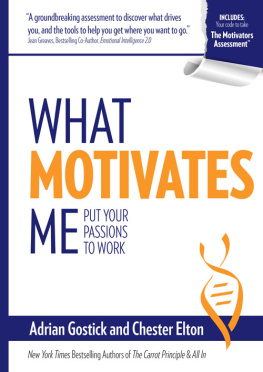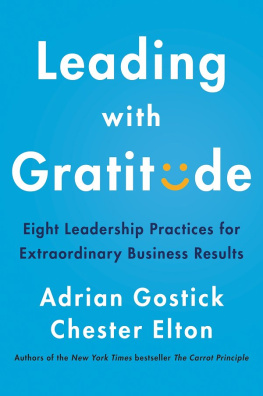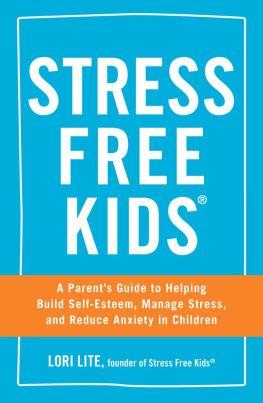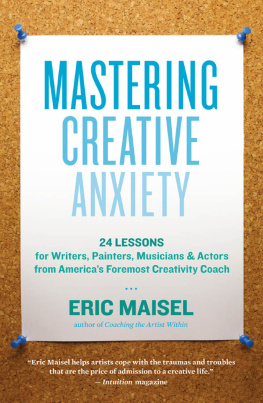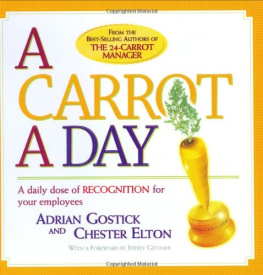Contents
Guide
To Anthony Gostick
This book is dedicated to one of its authors by the other two. Without Anthony, this book would not exist. His research and writing were foundational, but it was his never-ending passion for positive mental health that inspired us to create something that we hope will make the world a better place.
Contents
1
The Duck Syndrome
2
How Anxiety Fills the Gap
3
How to Turn Less into More
4
Clear Paths Forward
5
How Its Not Perfect Can Become Its Good, Ill Move On
6
From Conflict Avoidance to Healthy Debate
7
Become an Ally
8
Transform Exclusion into Connection
9
Turn Doubts into Assurance
It is not the strongest of the species that survives, nor the most intelligent, it is the one most adaptable to change.
Charles Darwin (paraphrased by Leon Megginson)
In early 2020, we were in Scottsdale, Arizona, to give a speech to the leadership team of a manufacturing company. Wed originally been scheduled to address the group at the end of the day, but the organizers kept moving our start time up. They wanted to end the day early because of the flood of fast-breaking news about the spread of the coronavirus.
Concentrating on the event proceedings was nearly impossible for the attendees with everyone constantly checking their phones for the latest news and texts from loved ones. Employees at the companys factories were asking if they should go home. Within a few days, hand sanitizer and toilet paper would inexplicably disappear from shelves, and within weeks, tens of thousands of people would be sick.
In the back of the ballroom we were huddled over our presentation, frantically changing it in real time. The material wed been asked to share on culture and employee engagement didnt seem nearly as relevant anymore. We decided we would instead unveil research wed been compiling about the growing problem of workplace anxiety, which was going to be even more urgent heading into a period of great uncertainty. It was clear that many jobs would be lost in the fallout of COVID-19, and those who kept their positions would be under great pressure. Data we were about to present would show that levels of anxiety at work had been steadily rising well before this; and we predicted that things were about to get a lot worse.
When we stepped onto the stage, at least half the audience members had their heads in their phones, yet by the end of our hour together, all of us were fully engaged in a discussion about the real issues that were happening right then to their people. These leaders grasped that they needed to be more informed about the nature of anxiety and how they could best help their team members cope.
In the airport that night, after scrubbing our seats with the Clorox wipes wed been lucky to score, we talked about the important role managers play in employees lives. We were gratified that many leaders had already shared with us keen insights about how theyd assisted anxiety-ridden employees in our research for this book. We noted that if anxiety levels had been rising before this pandemic, we could only imagine what was going to happen now.
A Growing Issue
For some time, we have been concerned about the increasing problem of workplace anxiety and the need to provide managers realistic and useful guidance. We began researching and writing this book because in most companies we worked with, we were hearing mounting frustration and bewilderment of leaders about this issue. Research told us they had good reason to be concerned long before the pandemic. In a 2018 survey, 34 percent of workers of all ages reported feeling anxiety at least once in the previous month, and 18 percent had a diagnosed anxiety disorder. And yet very little about the problem was being talked about in their companies, despite a significant economic impact.
Harvard Medical School research claimed on-the-job anxiety imperils workers careers and company productivity. Anxiety is leading to increased employee errors, growing burnout, workplace rage, more sick days, and poor employee health. Concerned? Us, too. Worry, stress, and resulting anxiety at work can cause employees to lose focus and withdraw, working at a reduced capacity and rebuffing attempts by fellow team members or managers to help.
As a quick education, people sometimes use the terms worry, stress, and anxiety interchangeably. While they may travel together, they are different. Worry is a mental processincluding repetitive, nagging thoughtsusually focused on a specific target like losing a job or wondering if youll get sick. Stress is a biological reaction when changes occur, to which the body responds physically, mentally, or emotionally. Anxiety involves the body and mind and can be serious enough to qualify as a mental disorder. Anxiety can combine stress, fear, and worry in ways that interfere with life.
There are two ways to refer to anxiety: the first is as a symptom of stress and worry; the second is as a classifiable disorder. As you might imagine, the effects of a rising tide of worry, stress, and anxiety have been incredibly expensive for organizations. In America, workplace anxiety is estimated to cost some $40 billion a year in lost productivity, errors, and health-care costs, while stress is estimated to cost more than $300 billion. The Organization for Economic Co-operation and Development in Paris offers an even more dour assessment of the effects in Europe, estimating the total costs of mental health problems at more than 600 billion euros annually, with anxiety being the most common issue.
Though the problem is becoming more serious with older employees, its been particularly acute with millennials and Gen Z. According to a 2019 study published in the Harvard Business Review, more than half of millennials and 75 percent of Gen Z reported they had quit a job for mental health reasons. In our consulting work, weve found that one of the greatest concerns among managers today is how to motivate younger workers. One leadership workshop Adrian conducted with a group of executives had especially driven home the problem. In the Q&A session, every one of their questions was about their younger workersspecifically about how they were having a hard time handling the pressures of their deadline-oriented business. One leader summed up the general concern for all: How do we get our young employees to cope better? I mean, we cant stop delivering.
A big part of the problem is employee anxiety, which can present as an overestimation of workplace threats (from personal issues such as Will I fit in? to organizational issues that may affect the stability of the company) and an underestimation of ones ability to cope. Yet sometimes anxiety is a general state of unease for no apparent reason. As Gen Z is now flooding into the workforce, a tidal wave of anxious young people are on their way to our businesses, says Michael Fenlon, chief people officer for PricewaterhouseCoopers, one of the nations biggest employers of newly minted college grads.
Weve found most young people want to be able to discuss their anxiety at work. Said one twenty-something employee in an interview, My generation talks about anxiety all the time to each other. Rightly so, they believe that its impossible to fix something we are scared to talk about. And yet in a 2019 survey of one thousand employed adults with anxiety, 90 percent judged it would be a bad idea to confide their situation to their bosses. Sad.
The profound realization from the pandemic is that our world is subject to destabilizing, long-lasting threats, which may arise seemingly out of nowhere and disrupt not only companies but the whole economy. That is affecting anxiety levels like nothing weve seen before. According to the U.S. Census Bureau, by May of 2020 more than 30 percent of all Americans of all ages were reporting symptoms of an anxiety disorder, including a remarkable 42 percent of people in their twenties.



